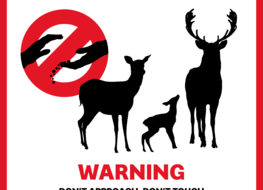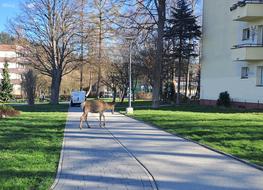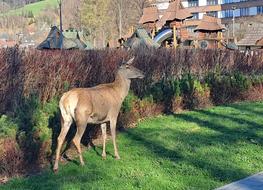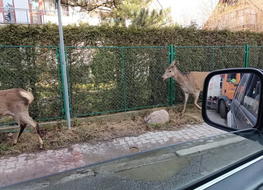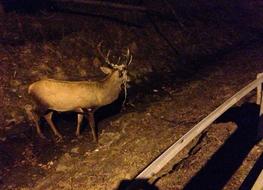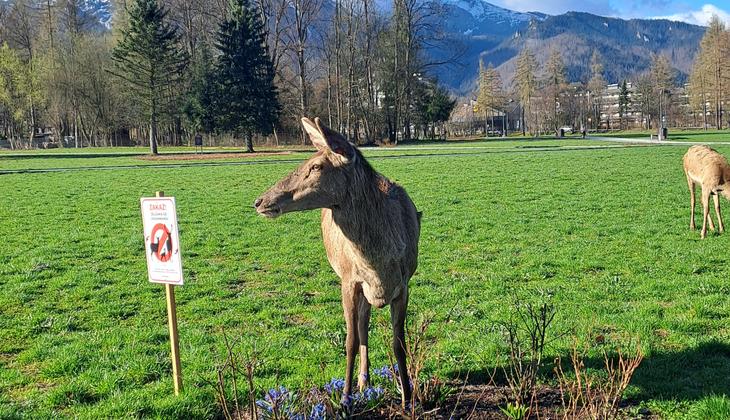
Przypominamy! Nie dokarmiaj dzikich zwierząt
Jeleń szlachetny, podobnie jak jego mniejsza krewniaczka - sarna, należy do rodziny jeleniowatych. Gatunki te są często mylone, można nawet spotkać się z opinią, że sarna jest samicą jelenia. Wystarczy jednak pamiętać, że samica jelenia (łania) osiąga wagę 80-120 kg, a samiec (byk) może ważyć nawet 150-200 kg. W przypadku sarny jest to odpowiednio – 18 i 25 kg.
Przebywanie jeleni wśród zabudowy miejskiej jest zjawiskiem niekorzystnym i wynika z postępującej od lat urbanizacji i związaną z tym łatwością zdobycia pokarmu przez zwierzęta. Pokarmem tym są nie tylko trawa na trawnikach, czy kwiatki na rabatach, ale przede wszystkim wyrzucane przez człowieka resztki jedzenia. Ponadto, często ludzie chcą karmić zwierzęta, by pomóc im w trudnych warunkach zimowych albo dla rozrywki, na przykład by zrobić sobie zdjęcie.
Dokarmiając dzikie zwierzęta (i błędnie zakładając, że jedzą one to, co ludzie), wyrządza się im krzywdę. Zwierzęta te żyją na ziemi od tysięcy lat i dają sobie radę bez udziału człowieka. Dokarmianie jest raczej zaspokajaniem naszych, ludzkich odruchów i potrzeb. Dieta zwierząt, ukształtowana w toku ewolucji, zmienia się w zależności od fazy rozwojowej i pory roku. Skutkiem dokarmiania jest pogorszenie stanu zdrowia dzikich zwierząt, które stają się słabsze i gorzej znoszą naturalne, trudne warunki klimatyczne.
Dokarmiając dzikie zwierzęta należy pamiętać, że nie poprawiasz ich losu. Przyzwyczajając je do łatwego zdobywania pokarmu powodujemy, że zatracają one lęk przed ludźmi i umiejętność poszukiwania naturalnego pokarmu. Zwierzęta takie mogą stanowić realne zagrożenie i stać się agresywne, domagając się pożywienia z rąk człowieka.
Jelenie są zwierzętami dzikimi działającymi instynktownie i nie jesteśmy w stanie przewidzieć ich reakcji na naszą obecność lub na bodźce z otoczenia. Spłoszone, mogą doznać urazu lub zabić się uciekając, a przez nagłe pojawienie się na drodze mogą doprowadzić do groźnych kolizji z samochodem.
Spotkanie jeleni w mieście dla wielu jest wielką atrakcją, którą chcą uwiecznić
na fotografii. Posiadane aparaty fotograficzne, również te w telefonach
komórkowych, pozwalają na wykonanie zdjęcia (selfie) bez konieczności
zbliżania się do zwierząt.
Uwaga!
- W przypadku spotkania z jeleniami zachowajmy bezpieczną odległość.
- Pamiętaj, aby ich nie dokarmiać i przez to nie oswajać! Przetrwają tylko wtedy, gdy pozostaną dzikie!
--------------------------------------------------------------------------------------------------------------------------------
Due to the fact that Zakopane is located in
close proximity to vast forests mainly situated within the borders of
the Tatra National Park, its’ built-up areas are regularly visited by
wild animals. The center of the town in particular is frequented by
deer. The red deer, like its smaller relative - the roe deer, belongs to
the family called Cervidae.
These species are often confused, and it is even believed that the roe deer is a female deer.However,
it is enough to remember that a female deer (hind) reaches a weight of
80-120 kg, and a male (buck) can weigh up to 150-200 kg.
In the case of roe deer, it is - 18 and 25 kg, respectively.
The presence of deer in highly urbanized districts is an unfavorable phenomenon and results from the excessive urbanization that has been progressing for years making it very easy for animals to get food, which consists not only of grass on lawns or flowers on flower beds, but, first and foremost, it includes food leftovers thrown away by humans. In addition, some people
start feeding deer on their own falsely believing that this would help these animals to survive in harsh winter conditions. Others, particularly tourists, consider this activity to be a great source of fun and entertainment since enticing deer with human food poses a memorable opportunity to take a holiday photo with a wild animal.
Nevertheless, we need to bear in mind that
feeding deer with what we consume in reality has a highly detrimental
impact on their organisms. These animals have lived on Earth for
thousands of years and have been able to cope without human
intervention. Therefore, it can be concluded that giving food to wild
animals is more about satisfying our own need of entertainment. In fact,
the diet of animals formed in the course of evolution changes depending
on their physical stage of development or seasons of the year. The
actual effect of providing deer with food is a gradual deterioration of
their health as they are getting weaker and unable to fend for
themselves in the face of challenging climate conditions.
When feeding wild animals, please note that you
are not improving their condition. By accustoming deer to easy food
acquisition, we cause them to lose their fear of people and the ability
to search for natural food.
Such animals can
behave aggressively and as a consequence pose a serious danger to
encountered humans while trying to get treats from them. Deer are wild
animals driven by their natural instincts so we are unable to predict
their reaction to our presence or to stimuli from the environment.
If
they are scared, they can get injured or kill themselves while running
away or suddenly appearing on the road, which in turn can lead to
dangerous collisions with cars as well.
For many, encountering deer in urban areas is a
highly exciting experience they want to capture in a photo. However,
nowadays it is no longer necessary to come close to deer or other wild
animals in order to take a picture with them as smartphone cameras
enable us to take
a selfie without having to approach the aforementioned creatures.
Attention!
- In the event of an encounter with deer, please keep a safe distance.
- Remember not to feed them and thus not to tame them! They will only survive if they remain wild!
Źródło: WOŚ
(APM)




